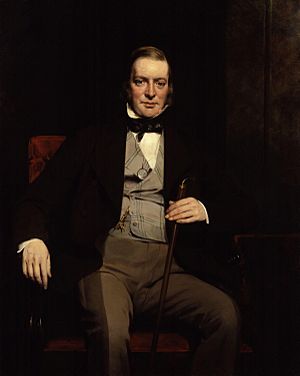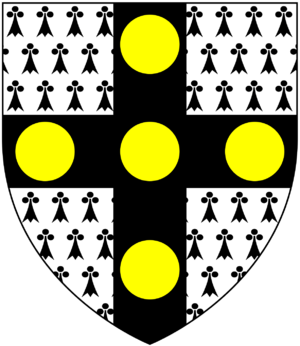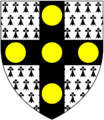Sir William Molesworth, 8th Baronet facts for kids
Quick facts for kids
Sir William Molesworth
|
|
|---|---|

Portrait by John Watson Gordon, 1854
|
|
| First Commissioner of Works | |
| In office 5 January 1853 – 30 January 1855 |
|
| Monarch | Victoria |
| Prime Minister | The Earl of Aberdeen |
| Preceded by | Lord John Manners |
| Succeeded by | Sir Benjamin Hall, Bt |
| Secretary of State for the Colonies | |
| In office 21 July 1855 – 22 October 1855 |
|
| Monarch | Victoria |
| Prime Minister | The Viscount Palmerston |
| Preceded by | Lord John Russell |
| Succeeded by | Henry Labouchere |
| Personal details | |
| Born | 23 May 1810 London |
| Died | October 22, 1855 (aged 45) |
| Nationality | British |
| Political party | Radical |
| Alma mater | University of Cambridge |
Sir William Molesworth, 8th Baronet (born May 23, 1810 – died October 22, 1855) was an important British politician. He was known as a Radical, which meant he wanted big changes in government. Sir William served in the government cabinet from 1853 until he passed away in 1855. He held two important jobs: First Commissioner of Works and later Secretary of State for the Colonies.
Contents
Early Life and Education
Sir William Molesworth was born in London in 1810. When he was just 13 years old, in 1823, he inherited the title of baronet. This meant he became "Sir William Molesworth, 8th Baronet." A baronet is a special title, like a knight, that can be passed down in a family.
He was taught at home before he went to St John's College, Cambridge, a famous university. Later, he moved to Trinity College, Cambridge. While there, he had a serious disagreement with his tutor and left the university. He also spent time studying in other countries and at Edinburgh University in Scotland. Sir William was also a member of the London Electrical Society, showing his interest in science.
Political Journey
Becoming a Member of Parliament
In 1832, a new law called the Reform Act 1832 was passed. This law changed how people could vote and made the government fairer. After this, Sir William Molesworth was elected to Parliament for the Eastern part of Cornwall. He supported the government led by Lord Grey.
He became friends with other important thinkers like George Grote and James Mill. In 1835, he helped start a magazine called the London Review. This magazine was a way for "Philosophic Radicals" to share their ideas. Later, he bought another magazine, the Westminster Review, and worked with John Stuart Mill to edit both.
Focus on Colonies and Reforms
Sir William Molesworth was very interested in how Britain managed its colonies around the world. He worked with others on plans to set up new communities in places like South Australia, Canada, and New Zealand.
From 1837 to 1841, he was a Member of Parliament for Leeds. He became well-known in Parliament for his speeches. He also led a special committee that looked into penal transportation, which was the practice of sending criminals to colonies.
Sir William spent a lot of his own money to publish the complete writings of a famous old philosopher named Thomas Hobbes. This was a huge project, but some people didn't like it. They tried to say that Sir William agreed with all of Hobbes's ideas, even the ones about religion and strong government, which caused him some trouble.
Return to Parliament and Cabinet Roles
After a few years out of Parliament, Sir William was elected again in 1845 for Southwark. He kept this seat until he died. When he returned, he focused even more on the colonies. He strongly believed that colonies should have more power to govern themselves.
In 1853, he joined the government cabinet led by Lord Aberdeen. He was the only Radical in this government. His first job was First Commissioner of Works. In this role, he helped build the new Westminster Bridge. He also made Kew Gardens open to the public on Sundays, which was a big deal at the time.
In July 1855, he was given an even more important job: Secretary of State for the Colonies. He held this position until his death in October of the same year.
Personal Life
Sir William Molesworth collected and published many of the works of Thomas Hobbes between 1839 and 1845. These works filled eleven books! They even included Hobbes's translation of the famous ancient Greek poem, the Iliad.
In 1844, Sir William married Andalusia Grant Carstairs. She was a singer and did not come from a noble family. Because of this, Sir William's family did not approve of their marriage.
Sir William Molesworth passed away on October 22, 1855, when he was 45 years old. He did not have any children, so his baronetcy title went to a cousin. He is buried in Kensal Green Cemetery in London.
A famous helper of the poor, John Passmore Edwards, put a special medal in a library in Southwark to remember Sir William Molesworth. This was to honor his important work and remind people of his good example.
The town of Molesworth in Victoria, Australia, is named after Sir William.
Images for kids
Further Reading
- Millicent Garrett Fawcett, Life of the Right Hon. Sir William Molesworth, London: Macmillan, 1901
- Alison Adburgham, A Radical Aristocrat: the Rt. Hon. Sir William Molesworth, Bart., PC, MP of Pencarrow and his wife Andalusia. (Padstow: Tabb House, 1980)




